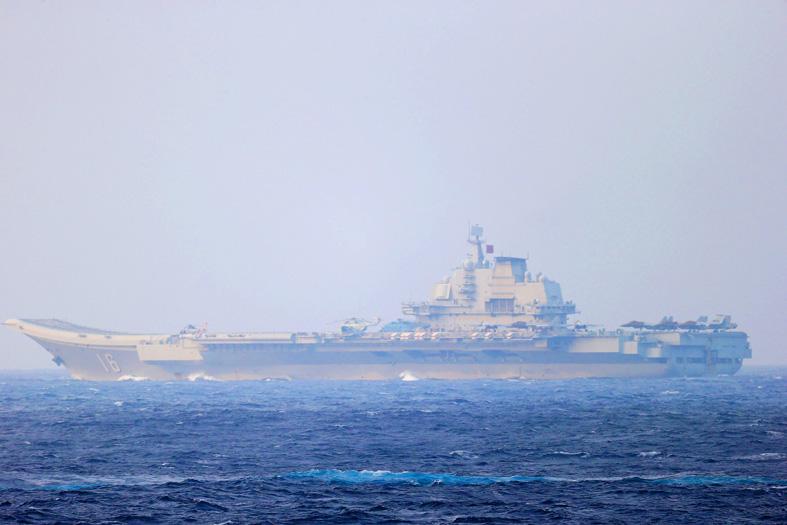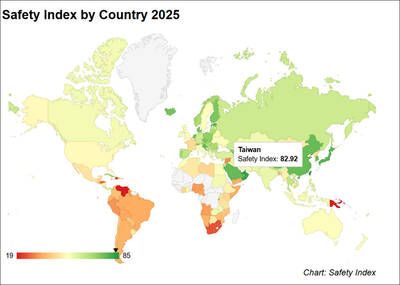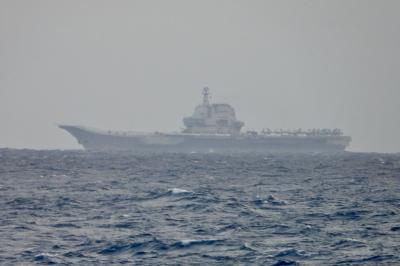A Chinese carrier group exercising near Taiwan is part of what are to be regular drills, the Chinese navy said in a statement late on Monday, further escalating tensions between Taipei and Beijing.
The group, including the aircraft carrier Liaoning, was conducting “routine” drills in the waters around Taiwan, a move to “enhance its capability to safeguard national sovereignty, safety and development interests,” the statement said.
“Similar exercises will be conducted regularly,” it said, without elaborating.

Photo: Reuters
The statement came after the Ministry of National Defense earlier on Monday issued a statement regarding a rise in the number of incursions by Chinese jets into its air defense identification zone (ADIZ) over the past few months.
The ministry said it had a “full grasp” of the situation in the air and at sea surrounding Taiwan and that it was “appropriately handling” the matter.
Beijing uses such methods to express its opposition to developments involving Taiwan, especially those with sovereignty implications.
Last week, when US Ambassador to Palau John Hennessey-Niland visited Taiwan along with Palauan President Surangel Whipps Jr, Beijing sent 10 planes into the nation’s ADIZ.
Tokyo has also voiced its concern over increased Chinese military activity, with Japanese Minister of Defense Nobuo Kishi yesterday telling NHK that Japan aims to closely monitor Chinese naval and air operations in the region.
The Japanese Ministry of Defense said on Sunday that the Liaoning, accompanied by five escort ships, had transited the Miyako Strait between Saturday and Sunday on their way to the Pacific.
Kishi said that he hoped that Taiwan and China could settle their differences in a peaceful manner.
A White House spokesperson last month said that Washington would continue to assist Taiwan with means to sufficiently defend itself.
In its most recent foreign affairs and national defense talks with Japan on March 16, the US affirmed the importance of stability and peace across the Taiwan Strait.
While pledging to continue the sale of upgraded warplanes, missiles and other defensive hardware to Taiwan, the US Navy yesterday said that its Theodore Roosevelt carrier strike group had entered the South China Sea on Saturday to conduct routine operations.
It is the second time the strike group has entered the area this year as part of the US 7th Fleet’s 2021 area of operations deployment.
The 7th Fleet said that the strike group would “conduct fixed and rotary-wing flight operations, maritime strike exercises, anti-submarine operations, coordinated tactical training and more” during its deployment.
Additional reporting by AP and CNA

AIR SUPPORT: The Ministry of National Defense thanked the US for the delivery, adding that it was an indicator of the White House’s commitment to the Taiwan Relations Act Deputy Minister of National Defense Po Horng-huei (柏鴻輝) and Representative to the US Alexander Yui on Friday attended a delivery ceremony for the first of Taiwan’s long-awaited 66 F-16C/D Block 70 jets at a Lockheed Martin Corp factory in Greenville, South Carolina. “We are so proud to be the global home of the F-16 and to support Taiwan’s air defense capabilities,” US Representative William Timmons wrote on X, alongside a photograph of Taiwanese and US officials at the event. The F-16C/D Block 70 jets Taiwan ordered have the same capabilities as aircraft that had been upgraded to F-16Vs. The batch of Lockheed Martin

GRIDLOCK: The National Fire Agency’s Special Search and Rescue team is on standby to travel to the countries to help out with the rescue effort A powerful earthquake rocked Myanmar and neighboring Thailand yesterday, killing at least three people in Bangkok and burying dozens when a high-rise building under construction collapsed. Footage shared on social media from Myanmar’s second-largest city showed widespread destruction, raising fears that many were trapped under the rubble or killed. The magnitude 7.7 earthquake, with an epicenter near Mandalay in Myanmar, struck at midday and was followed by a strong magnitude 6.4 aftershock. The extent of death, injury and destruction — especially in Myanmar, which is embroiled in a civil war and where information is tightly controlled at the best of times —

Taiwan was ranked the fourth-safest country in the world with a score of 82.9, trailing only Andorra, the United Arab Emirates and Qatar in Numbeo’s Safety Index by Country report. Taiwan’s score improved by 0.1 points compared with last year’s mid-year report, which had Taiwan fourth with a score of 82.8. However, both scores were lower than in last year’s first review, when Taiwan scored 83.3, and are a long way from when Taiwan was named the second-safest country in the world in 2021, scoring 84.8. Taiwan ranked higher than Singapore in ninth with a score of 77.4 and Japan in 10th with

China's military today said it began joint army, navy and rocket force exercises around Taiwan to "serve as a stern warning and powerful deterrent against Taiwanese independence," calling President William Lai (賴清德) a "parasite." The exercises come after Lai called Beijing a "foreign hostile force" last month. More than 10 Chinese military ships approached close to Taiwan's 24 nautical mile (44.4km) contiguous zone this morning and Taiwan sent its own warships to respond, two senior Taiwanese officials said. Taiwan has not yet detected any live fire by the Chinese military so far, one of the officials said. The drills took place after US Secretary